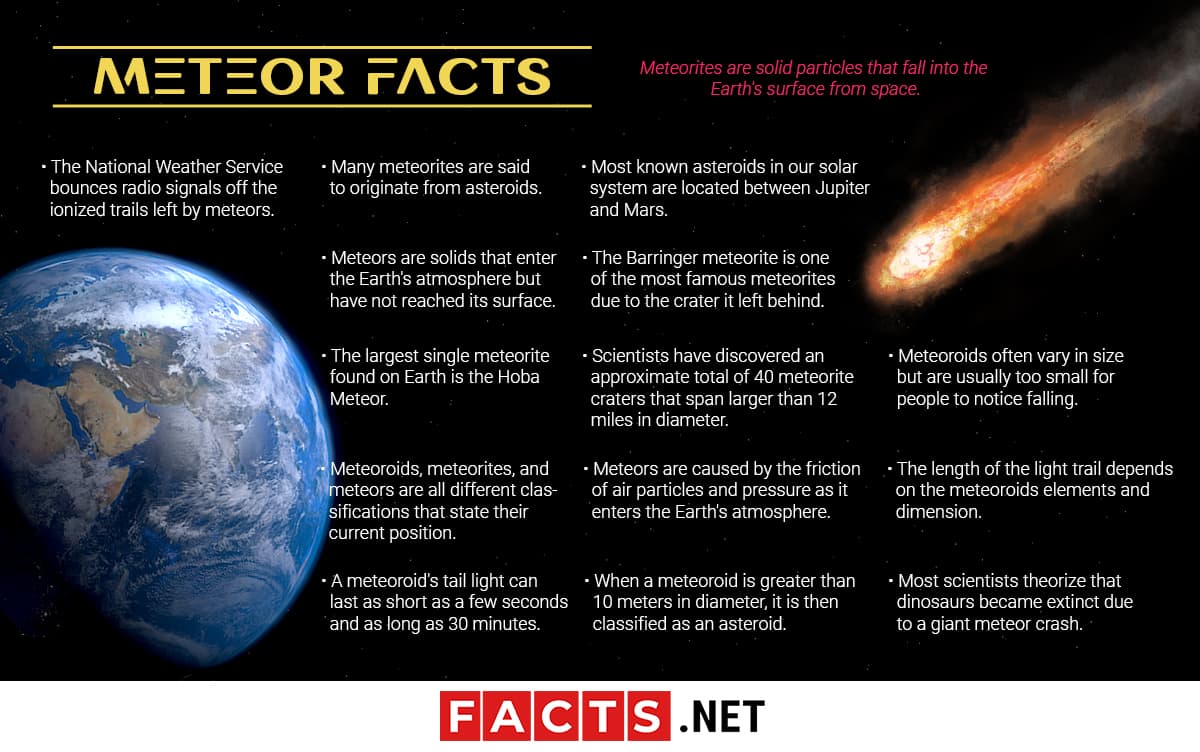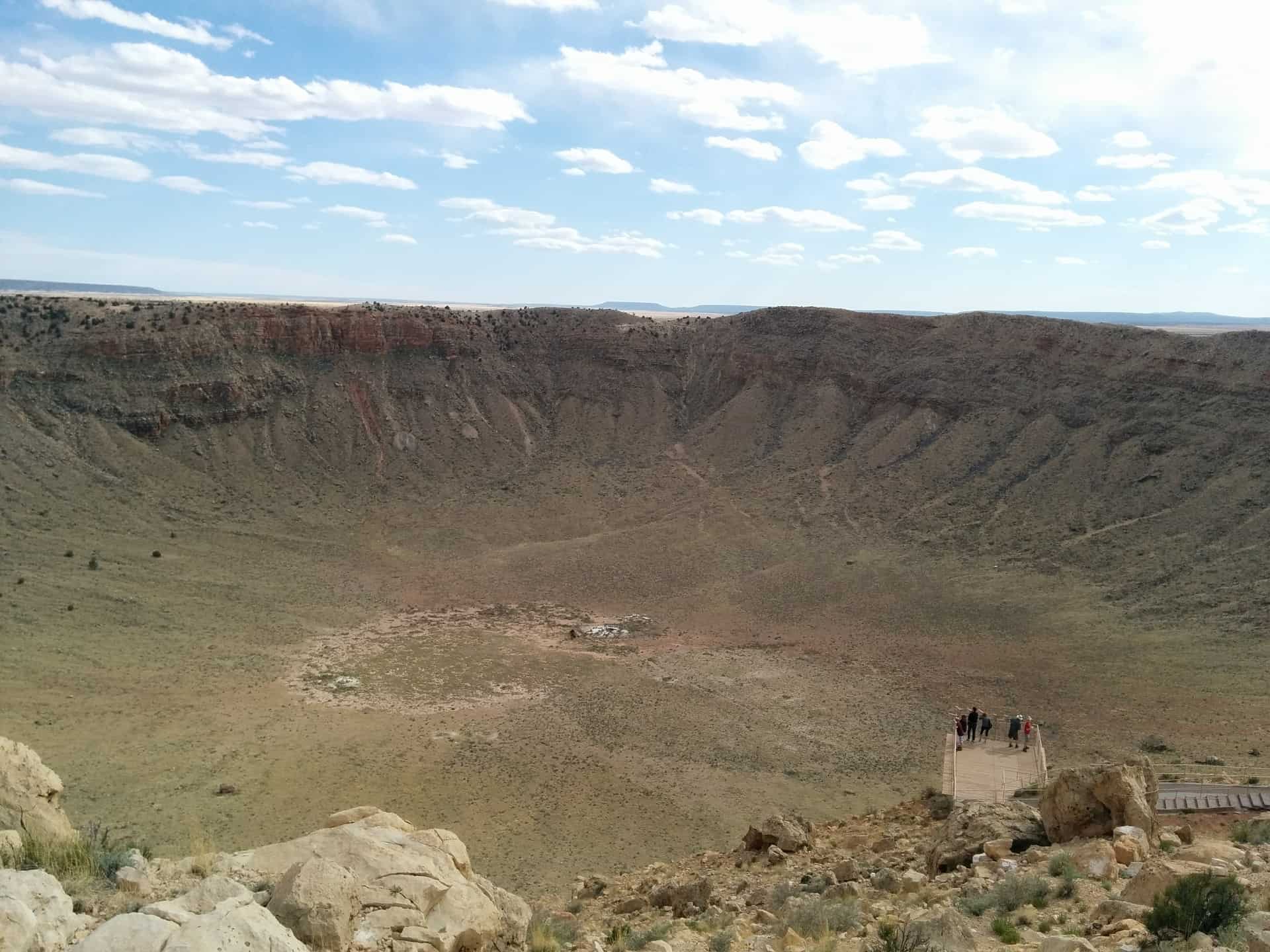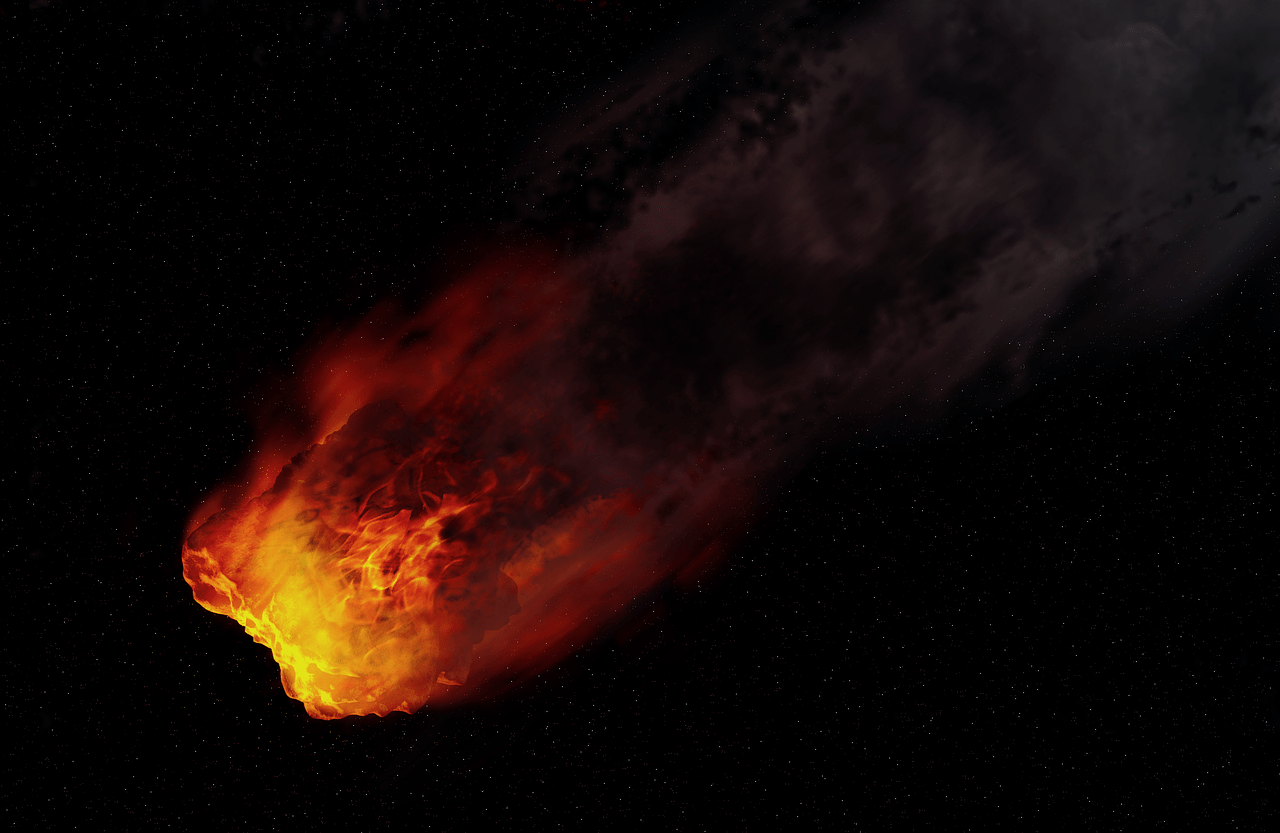
Meteors are a small body of matter that originates from outer space and enter the Earth. As a result of friction, it appears as a streak of light in the sky. Watching meteor showers or discovering a meteorite can often be an exciting experience. For some, it is a once in a lifetime experience. But how much do you know about these fragments from far beyond?
- eBay lists more than one thousand meteorites for auction online.
- Martian meteorites can be sold for as much as 500 dollars per gram.
- Most meteors are minuscule in size.
- Scientists claim that there are over 4 billion meteors that fall into the Earth every single day.
- Meteors are said to contain the oldest known rocks in the universe.
- The Nomenclature Committee of the Meteoritical Society demands 20% or 20g of all meteorites found for research. They take whichever amount is smaller, after that you may sell what is left of your meteorite.
- Out of the 24,000 meteors that have landed on Earth, only 34 is believed to have originated from Mars.
- All meteors are protected by the National Heritage Law. These meteors must be surrendered to authorities unless found within the borders of South Africa.
- The annual Perseids is the most famous and spectacular meteor shower.
- A meteoroid suffers from an identity crisis upon landing on Earth and becomes a meteorite.
- Only one injury has ever been verified from a meteorite impact.
- A meteor refers to the streak of light we see tailing the meteoroid.
- Perseid meteoroids travel at a speed of 130,000 mph.
- The international space station is covered with a foot thick blanket of Kelvar to protect it from meteorite impacts.
- A study in 1985 calculated that the rate of impacts on humans is 0.0055 per year.
- A meteoroid is defined as any interplanetary object bigger than a speck of dust and smaller than an asteroid.
- Perseid is known as the Tears of Saint Lawrence
- A 30ft wide meteoroid struck the atmosphere of Antarctica in 2004.
- President Clinton canceled the spacecraft project designed to defend the planet against meteoroids.
- A way of deflecting a meteor is to use a method called the X-ray slap.
Meteor Facts Infographics

The National Weather Service bounces radio signals off the ionized trails left by meteors.
This is also known as Meteor Burst Communication or Meteor Scatter Communications. This is used to collect data from automated weather stations as well as occasional data from respective US government agencies.
Most meteors scatter communications are conducted between radio stations which are engaged in a particular schedule of transmission and reception periods. Many other countries and locations in the United States use similar methods of data collecting in remote areas.
Meteorites are solid particles that fall into the Earth's surface from space.

This is often a solid piece of debris from foreign objects such as comets, asteroids, or even meteoroids. These are considered as meteorites if they remain intact from its passage from outer space through the atmosphere to the surface of a planet or moon.
Many meteorites are said to originate from asteroids.
It can be difficult at times to distinguish a meteorite from a regular Earth rock simply just by its looks alone. Although in certain areas of the world, distinguishing differences between the two become more simple.
For example, desert rocks and dark meteoroids stand out very clearly from one another. Similar meteorites can also be easier to spot in locations with colder weather and frozen plains.
Most known asteroids in our solar system are located between Jupiter and Mars.
Research has found that the main meteor belt resides and orbits between the two planets. This main asteroid belt is found to be more than two and a half times as far as the Earth is from the sun.
The current known asteroid count on this orbit is 840,170.
Meteors are solids that enter the Earth's atmosphere but have not reached its surface.
Meteors come in a range of sizes. These can be as small as a dust particle we see under sunlight, or as big as a house. The term meteor also comes from the Greek word, meteoron.
This translates to a phenomenon in the sky. The Greeks used this term to define the streaks of light in the sky when meteors would fall into the Earth’s atmosphere.
The Barringer meteorite is one of the most famous meteorites due to the crater it left behind.
The crater this meteorite created measured approximately 37 km east of Flagstaff and around 18 miles west of Winslow. The meteor crater lies at an elevation of 5,640 ft above sea level.
This crater is also around 3,900 ft in diameter and 560 ft deep.
The largest single meteorite found on Earth is the Hoba Meteor.
This meteorite measures at 9ft by 9ft by 3ft. The Hoba meteor is short for Hoba West and lies on a farm of the same name.
This meteorite had been uncovered but never moved from its impact due to its large mass. It is measured to be more than 60 tonnes.
This meteorite is famous for being the largest one still intact after collision. It is also the largest naturally occurring piece of iron known on the Earth’s surface.
The name Hoba comes from the Khoekhoegowab word which means gift.
Scientists have discovered an approximate total of 40 meteorite craters that span larger than 12 miles in diameter.
Around a hundred and twenty impact craters have also been identified on Earth in total. The most recent impact for a crater this big was last reported in 1908.
This was reported to have occurred in an uninhabited area of western Siberia that is known as Tunguska. The impactor was about 60 meters in diameter and consists of many loose pieces.

Meteoroids often vary in size but are usually too small for people to notice falling.
These meteorites also more commonly fall into bodies of water and are usually never recovered or studied. Research suggests that up to three hundred tons of space dust, including micrometeorites, fall to the Earth every day.
While hundreds may fall from outer space daily, it is about 90-95% safe. This is because most meteors completely burn up in the atmosphere before reaching the surface of the planet.
Meteoroids, meteorites, and meteors are all different classifications that state their current position.
A meteoroid is made up of smaller rocks or particles that are in orbit around the sun. A meteor is called such only if it enters the Earth’s atmosphere and vaporizes.
This is what people often call a shooting star. A meteorite is a small asteroid that has survived its passage through the planet’s atmosphere.
This is considered a meteorite if it passes this stage and lands on the planet’s surface.
Meteors are caused by the friction of air particles and pressure as it enters the Earth's atmosphere.
Meteor showers occur when the planet is in orbit around the sun and it passes through debris leftover from the disintegration of other comets. Most of these comets orbits are a bit more elongated compared to the orbit of the sun.
The length of the light trail depends on the meteoroids elements and dimension.
The bright trail of light is caused by the meteoroid during its atmospheric flight. As the meteoroid falls, it begins to burn and intensifies as it falls.
This process is called adiabatic compression. The visible tail can go up to over 150 million km in length.
The tail also always streams in the opposite direction from the sun.

A meteoroid's tail light can last as short as a few seconds and as long as 30 minutes.
However, streams of debris left behind in space can last for days, or sometimes even weeks.
When a meteoroid is greater than 10 meters in diameter, it is then classified as an asteroid.
Asteroids are rocky forms that orbit around the sun. However, they cannot be called planets because of their small sizes.
There are millions of asteroids orbiting outer space and despite their small size, they can be dangerous if it crashes into our planet. In total, the mass of all asteroids is less than that of the Earth’s moon.
Most scientists theorize that dinosaurs became extinct due to a giant meteor crash.
The Chicxulub crater is what scientists rely on for evidence to support this theory. The impact specifies that it had a diameter of 11-81 km and caused an energy blast measuring up to 21-921 billion Hiroshima bombs worth.
This impact is what is believed to have killed all living organisms such as dinosaurs and plants during prehistoric times.
Was this page helpful?
Our commitment to delivering trustworthy and engaging content is at the heart of what we do. Each fact on our site is contributed by real users like you, bringing a wealth of diverse insights and information. To ensure the highest standards of accuracy and reliability, our dedicated editors meticulously review each submission. This process guarantees that the facts we share are not only fascinating but also credible. Trust in our commitment to quality and authenticity as you explore and learn with us.
